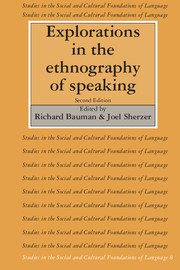Book contents
- Frontmatter
- Contents
- INTRODUCTION TO THE SECOND EDITION
- I PREFACE AND INTRODUCTION
- II COMMUNITIES AND RESOURCES FOR PERFORMANCE
- III COMMUNITY GROUND RULES FOR PERFORMANCE
- IV SPEECH ACTS, EVENTS, AND SITUATIONS
- V THE SHAPING OF ARTISTIC STRUCTURES IN PERFORMANCE
- Introduction
- 14 Correlates of Cree Narrative Performance
- 15 An Analysis of the Course of a Joke's Telling in Conversation
- 16 When Words Become Deeds: An Analysis of Three Iroquois Longhouse Speech Events
- 17 The Ethnographic Context of Some Traditional Mayan Speech Genres
- 18 To Speak with a Heated Heart: Chamula Canons of Style and Good Performance
- VI TOWARD AN ETHNOLOGY OF SPEAKING
- Notes
- References
- Index of names
16 - When Words Become Deeds: An Analysis of Three Iroquois Longhouse Speech Events
Published online by Cambridge University Press: 05 June 2012
- Frontmatter
- Contents
- INTRODUCTION TO THE SECOND EDITION
- I PREFACE AND INTRODUCTION
- II COMMUNITIES AND RESOURCES FOR PERFORMANCE
- III COMMUNITY GROUND RULES FOR PERFORMANCE
- IV SPEECH ACTS, EVENTS, AND SITUATIONS
- V THE SHAPING OF ARTISTIC STRUCTURES IN PERFORMANCE
- Introduction
- 14 Correlates of Cree Narrative Performance
- 15 An Analysis of the Course of a Joke's Telling in Conversation
- 16 When Words Become Deeds: An Analysis of Three Iroquois Longhouse Speech Events
- 17 The Ethnographic Context of Some Traditional Mayan Speech Genres
- 18 To Speak with a Heated Heart: Chamula Canons of Style and Good Performance
- VI TOWARD AN ETHNOLOGY OF SPEAKING
- Notes
- References
- Index of names
Summary
Among the modern Longhouse Iroquois, whose eastern population is spread over twelve reserves in Quebec, Ontario, and New York state, there has survived an ancient oratorical tradition which enters into almost every phase of traditional religious and political life. This is the thread that runs through the diverse institutions of the Handsome Lake religion, the Confederate Council of the Iroquois League, the individual rites surrounding death and curing, and the ceremonies of the agricultural cycle. The sight of speaker after speaker representing a family, a clan, a ‘side of the fire’ (moiety), or a whole nation, and taking his turn at formal talk, is familiar to all those who have worked with the conservative Iroquois. I have summarized elsewhere the different categories of speakers who carry this tradition, and have discussed their training and standards for successful performance (Foster 1971). In this paper I want to narrow the concern to a set of three closely related speeches. Except as specific qualifications will be made, all of these are associated with the agricultural ceremonies.
The speeches can be separated into two sets of one and two speeches respectively, depending upon their ritual purposes as conceived by the Longhouse people. In a set by itself is the kanṍhõnyõk ‘let there be thanks’ which is usually referred to in English as the Thanksgiving Address. Its purpose is to give thanks to the Creator for the many benefits of the natural world.
- Type
- Chapter
- Information
- Explorations in the Ethnography of Speaking , pp. 354 - 367Publisher: Cambridge University PressPrint publication year: 1989
- 3
- Cited by



